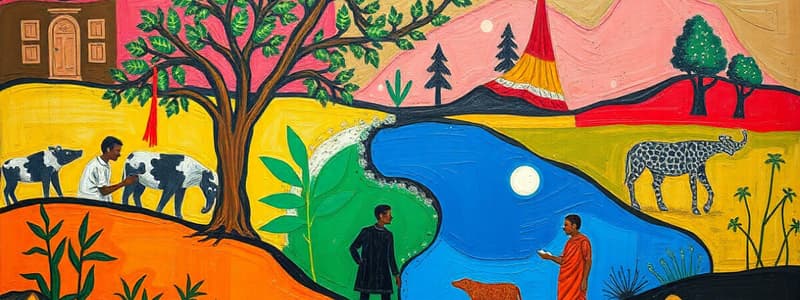Podcast
Questions and Answers
What major issue in Pakistan's economy relates to diminishing water resources?
What major issue in Pakistan's economy relates to diminishing water resources?
- Water Scarcity (correct)
- Energy Crisis
- Low Literacy Rates
- Debts
What are the consequences of environmental degradation in Pakistan?
What are the consequences of environmental degradation in Pakistan?
Deforestation, soil erosion, and loss of biodiversity
Pakistan's education system is well-funded and leads to high literacy rates.
Pakistan's education system is well-funded and leads to high literacy rates.
False (B)
What is a significant consequence of 'brain drain' in Pakistan?
What is a significant consequence of 'brain drain' in Pakistan?
What major issue does Pakistan face in relation to trade?
What major issue does Pakistan face in relation to trade?
Name one of the consequences of high poverty rates in Pakistan.
Name one of the consequences of high poverty rates in Pakistan.
Which of the following is a factor contributing to unemployment in Pakistan?
Which of the following is a factor contributing to unemployment in Pakistan?
The 1st Five-Year Plan focused primarily on ______ and irrigation.
The 1st Five-Year Plan focused primarily on ______ and irrigation.
What was one outcome of the 2nd Five-Year Plan?
What was one outcome of the 2nd Five-Year Plan?
Debt servicing takes up a small portion of Pakistan's national budget.
Debt servicing takes up a small portion of Pakistan's national budget.
Flashcards are hidden until you start studying
Study Notes
Natural Resources
- Pakistan heavily relies on agriculture, consuming a significant amount of water
- Water scarcity is a major issue due to diminishing resources and poor water management
- Energy crisis persists despite natural resources like coal and gas
- Environmental degradation, including deforestation, soil erosion, and biodiversity loss, stems from unsustainable resource overuse
Human Resources
- Low literacy rates result from historical underfunding of the education system
- Brain drain occurs as educated individuals seek opportunities abroad, leading to a loss of skilled human capital
- Gender inequality limits women's participation in the workforce due to cultural, social, and institutional barriers
Unproductive Expenditure
- Defense spending consumes a significant portion of the budget, limiting development spending
- Subsidies to inefficient public-sector enterprises and energy subsidies contribute to fiscal imbalances
Trade Issues
- Pakistan experiences a trade deficit, with imports exceeding exports
- Low export diversification, heavily reliant on textiles, hinders economic growth and foreign exchange reserves
Debt Burden
- Pakistan faces a significant external debt burden
- Debt servicing consumes a considerable chunk of the national budget
- Debt dependency on international institutions like the IMF creates a cycle of borrowing and repayment
Income Distribution
- Wealth inequality is prevalent, with the wealthiest controlling a disproportionate share of resources
- Urban-rural disparity widens economic gaps, with rural areas facing poverty and limited opportunities
Poverty
- High poverty rates, particularly in rural areas, are exacerbated by limited access to basic services
- Inflation and food insecurity worsen poverty levels, making it difficult to meet essential needs
Unemployment
- Youth unemployment is high due to insufficient job creation and a mismatch between education and market demands
- Underemployment is common, with individuals working in low-productivity sectors for meager earnings
Limited Human Resource Development
- Pakistan historically underinvested in education and health, resulting in poor outcomes
- Lack of focus on technical and vocational training creates a skilled labor gap in key sectors
Historical Context- Pakistan's Development Plans
1st Five-Year Plan (1955-1960)
- Focused on agriculture and irrigation to increase food production and reduce food imports
- Underperformed due to lack of infrastructure and weak institutional capacity, resulting in missed industrialization targets
2nd Five-Year Plan (1960-1965)
- Shifted focus to industrialization and import substitution, encouraging private sector investment
- Launched significant infrastructure projects like the Mangla Dam
- Relatively successful, leading to moderate industrial growth, but also increased economic inequality
3rd Five-Year Plan (1965-1970)
- Continued focus on industrial growth with additional emphasis on the development of basic industries
Studying That Suits You
Use AI to generate personalized quizzes and flashcards to suit your learning preferences.




